Creativity, passion and ancient traditions handed down through the generations are the ingredients that have made handmade in Italy famous all over the world.
From tailoring to metalworking, from glass to ceramics, without forgetting wood or papier-mâché, and so much more.
Even today, throughout Italy, small and large workshops or even proper schools can be found carrying on these ancient crafts with respect and love, despite the many difficulties.
Let's find out together where to go to admire up close this timeless art and get to know the keepers of its secrets.

Italian handmade glass: not only Murano
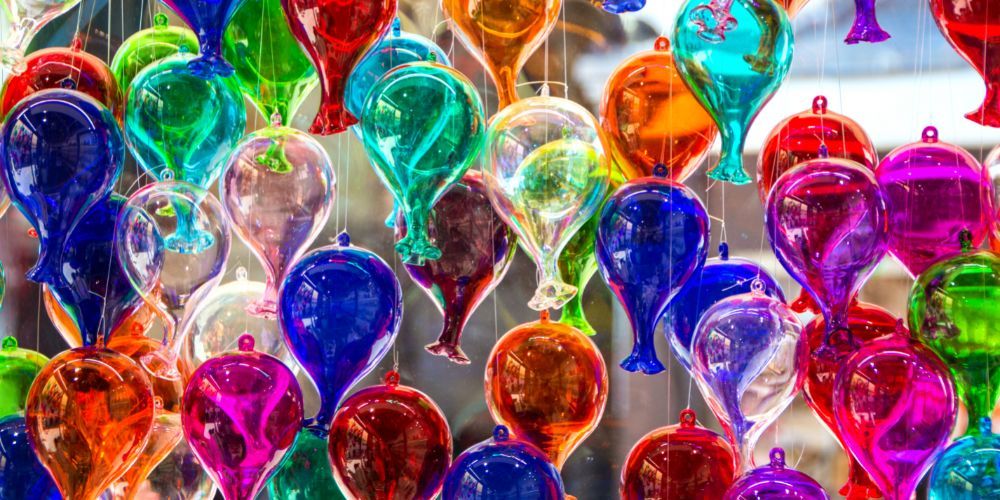
When we talk about glass craftsmanship in Italy, we inevitably think of the spectacular workshops of Murano, near Venice. Colorful, fancy, of all shapes and sizes, Murano glass has rightly deserved its fame. Did you know that in Venice you can also enjoy an authentic experience by witnessing the glasswork of master glassmakers? Here's how.
Visit Glass Museum with Venice PassHowever, fans of this art can find much more in Italy.
In Tuscany, and in particular, in Empoli, glass has been produced for several centuries; archaeological excavations have even brought to light some ancient furnaces. Initially the production of glass in this area was linked to that of wine, therefore focused on flasks and bottles, but for some time now, handmade blown glass has also been produced for the decorative arts and interior design.
In nearby Val d'Elsa a particular type of glass is also produced. In fact, the production of 95% of Italian crystal is concentrated here, equal to 14% of the world production. Here is the only crystal museum in Italy and here, upon reservation, you can visit many engravers' and grinders' workshops.
If you love artistic stained glass you should also organize a trip to Milan and its surroundings, where there are ateliers and galleries where you can admire beautiful religious and non-religious works of this particular art.
Last but not least, Altare, in Liguria, is another of the capitals of glass in Italy. According to tradition, it was the Benedictine monks who founded the first furnaces, in the early Middle Ages, while the local masters were inspired by the Venetian ones, and being also great travelers they exported their techniques and masterpieces all over the world.
You will be able to learn more about the centuries-old history of this art also thanks to the glass museum dedicated indeed to the local production.
Handmade paper and paper-maché: art, folklore and tradition
Papermaking is a tradition that dates back to the Middle Ages and which immediately took root in Italy. Even today there are many active paper mills throughout the country but if industrial methods have supplanted artisanal ones almost everywhere, the traction of handmade paper luckly has not been lost.
Amalfi in Campania and Fabriano in the Marche contend the leadership thanks to their historic paper mills that still produce top quality paper. There are also two museums where you can observe the oldest and most interesting processing methods. In Mele, in Liguria, there is another small, interesting museum dedicated to this product.
The tradition, however, has remained alive almost everywhere in Italy. In Florence, Turin and Naples there are still not only excellent master paper makers but also awesome handcrafted binderies.
Another art form was born from paper, one that in Italy has been able to reach the highest levels. It's papier-mâché, a light, versatile, inexpensive material that still has two of its centers of excellence in Naples, Venice, and Acireale (in Sicily), with laboratories, museums and shops that are a sight to behold. Not to mention the long and prestigious papier-mâché tradition of Lecce, in Puglia.
Ceramics: majolica, porcelain, terracotta and all the colors of Italian handmade
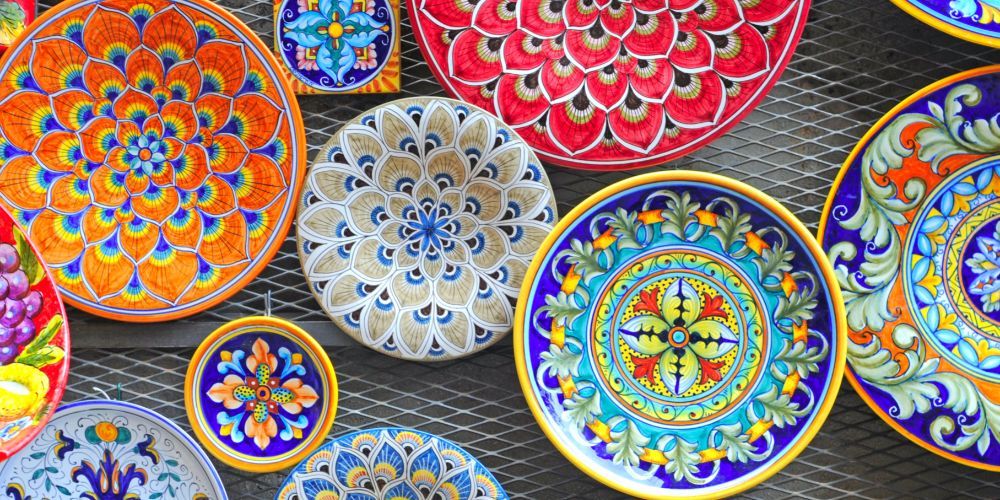
Handmade ceramics, in all its most colorful and creative variations, is an artisan tradition so rooted in Italy, that one could travel through all the country, from workshop to workshop, and never be disappointed.
If each region has its own traditions, there are however some areas where this art has reached particularly high peaks.
Faenza in Emilia Romagna and Albissola in Liguria are among the most important centers in northern Italy for handmade ceramics. Furthermore, in Burio, near Bologna, the tradition of the ocarina, a small terracotta musical wind instrument, is so loved that there is even a museum dedicated to it.
In central Italy there are hundreds of lathes constantly at work to produce basically everything, from simple decorative bowls, to amphorae as large as a room, or to the colorful tiles that reproduce scenes of daily life, sacred subjects, and anything else the imagination may suggest. Montelupo and Siena in Tuscany are just two of the places where you can find beautiful Renaissance-style artifacts. Deruta and Orvieto, beautiful towns in Umbria, are full of shops and laboratories and are unmissable as well. Those traveling between Marche and Abruzzo, on the other hand, should absolutely make a stop in Castelli or Urbania.
If you love this art form you just cannot miss the southern regions. Naples has reached very high peaks with porcelain, whose techniques are still handed down in the school located inside the beautiful park of the former royal palace, now a museum. Vietri, in addition to being one of the pearls of the Amalfi coast, is also one of the Italian capitals of this ancient art, which here is still more alive than ever. The same can be said of Grottaglie in Puglia. A simple walk in the center of these two towns is enough to find yourself immersed in a world of colours.
An inimitable style also defines the ceramics of Caltagirone, in Sicily, where the union of Arab and local culture has generated unmistakable masterpieces, famous all over the world. In Sardinia too, ceramics is one of the many reasons of pride for local craftsmen. It's a tradition that has existed since the dawn of time, which has developed here with unique shapes and decorative motifs.
A man who works with his hands is a worker; a man who works with his hands and his brain is a craftsman; but a man who works with his hands, his brain and his heart is an artist.
His majesty, the wood, protagonist of italian handmade
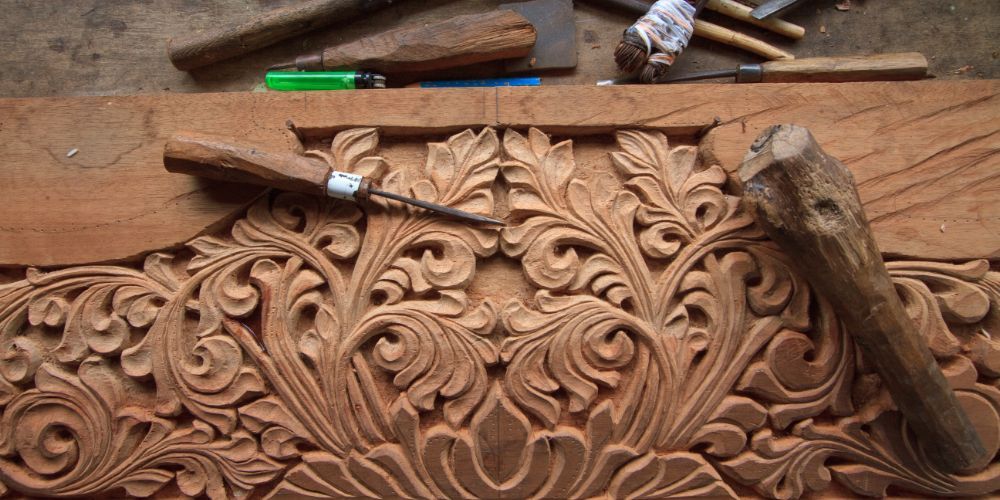
One of the most versatile materials, techniques that have been preserved or evolved over the centuries and a passion that has never run out. Wood, capable of conveying a feeling of warmth and familiarity, continues to have thousands of admirers.
Venice boasts a long tradition and there are still some workshops, in town, where the jewels known as moretti veneziani are handmade in ebony and precious materials. Venice is also the homeland of the gilders, craftsmen capable of embellishing every wooden artifact with thin gold leaves, including, at least in the past, ships.
In Sorrento, on the other hand, the workshops of the inlayers still survive, albeit with some difficulty, and here they have been able to develop a unique and immediately recognizable style.
Sutrio, in Friuli, is a wonderful village where the craftsmanship of wood is a true art form. For centuries local artisans have created masterpieces, and the love for wood has also given life to an event held every year in September. It's the perfect opportunity to learn about the local culture and the ability of the craftsmen.
In Modena, instead, the art of wood meets the finest gastronomy. In fact, one of the local excellences, the balsamic vinegar, is kept in maple, chestnut or ash wood barrels and in these lands you can also find masters coopers who make them with artisanal methods, in shops that sometimes have existed for several centuries.
The pipes of Cantù, in the province of Como, are famous as well. They are made of wood, of course, and of such high quality to be known and appreciated by collectors and smokers all over the world. Cantù also has its wood festival, in October, where you can observe the work of the craftsmen more closely or join a creative workshop.
Equally valuable and original is the tradition of the wood of Arischia in Abruzzo and Chiavari in Liguria where the sideboards and the typical Chiavari chairs are respectively produced, and obviously handmade.
Coral, the red gold of the Mediterranean Sea
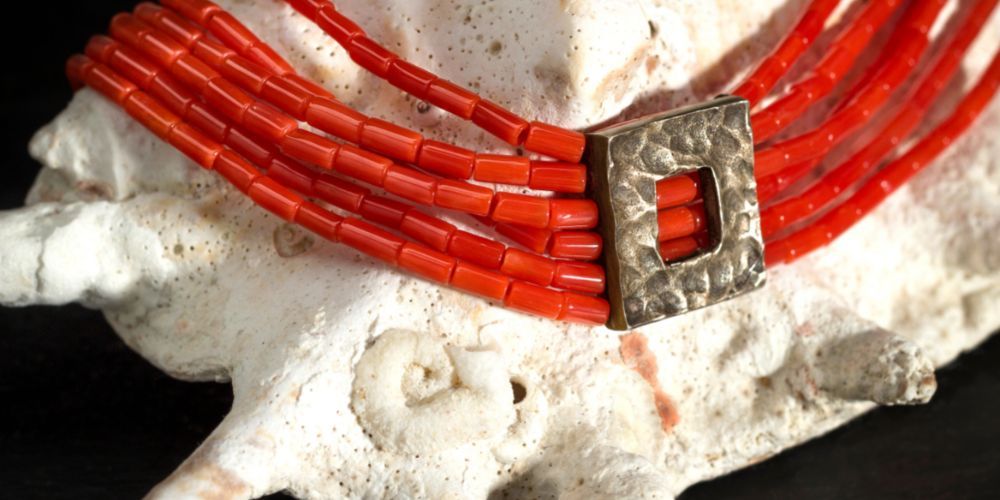
An item known since ancient times, loved for its beauty, its value and also for the skill with which the craftsmen have always managed to transform it into precious objects with a timeless charm.
Coral, according to the legend narrated by Ovid, is supposed to be born from the blood of the mythological creature Medusa, and has magical healing properties. What is certain is that in Campania, in particular in Torre del Greco, Capri and Ischia, the craftsmanship of the red gold of the Mediterranean has not only never faded, on the contrary, it keeps on reaching a very high quality. There is also a reknown school where young jewelers study to keep the tradition alive.
In Alghero too, in Sardinia, coral craftsmanship is well known and still practiced. There is also an interesting museum in town, dedicated to this wonderful art.
Last but not least, Trapani in Sicily is considered among the Italian capitals of handmade coral, and rightly so. Unfortunately, today there are very few craftsmen still in business, but coral has been produced here for almost a thousand years. The past centuries have left behind a long tradition and many artworks, including, not only jewels but also monumental, spectacular sculptures.
Italian fashion and the art of handmade fabrics
Haute couture and Italy have certainly formed an indissoluble bond for about a century now, but top-notch tailoring has actually been around for much longer across the whole country.
Both Florence and Venice, for example, albeit for different historical reasons, have nevertheless achieved the same fame for the production of wool and silk, from which comes fine velvets too. For example, the soprarizzo of Venice, with its complex and expensive workmanship, or the damask of Florence are rightly famous. Equally precious is the macramé velvet from Liguria, with its awesome embroideries. Even today these are handmade products, used both for furniture and fashion.
The silk factory of San Leucio, in Campania, achieved fame in the 19th century, attracting the attention of nobles from all over Europe. Today some of the ancient factories still work and can be visited.
Those looking for a perfect made-to-measure suit will never be disappointed in Naples, where every fabric is worked by tailors from a long tradition. They can make basically every kind of suit or accessory, from coats, to gloves, from ties to umbrellas and so on. Rome, Florence and Milan are also very rich cities in this sense, where you can find both small workshops and the most elegant ateliers.
In Turin, on the other hand, there are historic hat shops or shirt shops often chosen by VIPs.
For practical reasons, leather was mostly worked close to a river, that's why even now the best handmade leather accessories can be found in Florence, Rome or Modena.
Sardinia, on the other hand, boasts a particular record. The traditional dresses are many and all different and beautiful, but Samugheo, Mogoro and Aggius in the north, have a long female tradition of carpets weaving. They were and still are made using special vertical looms that draw geometrical patterns. An important artistic craft fair and a weaving museum help to keep alive this still flourishing tradition.
Iron and precious metals: from "poor" art to goldsmithing
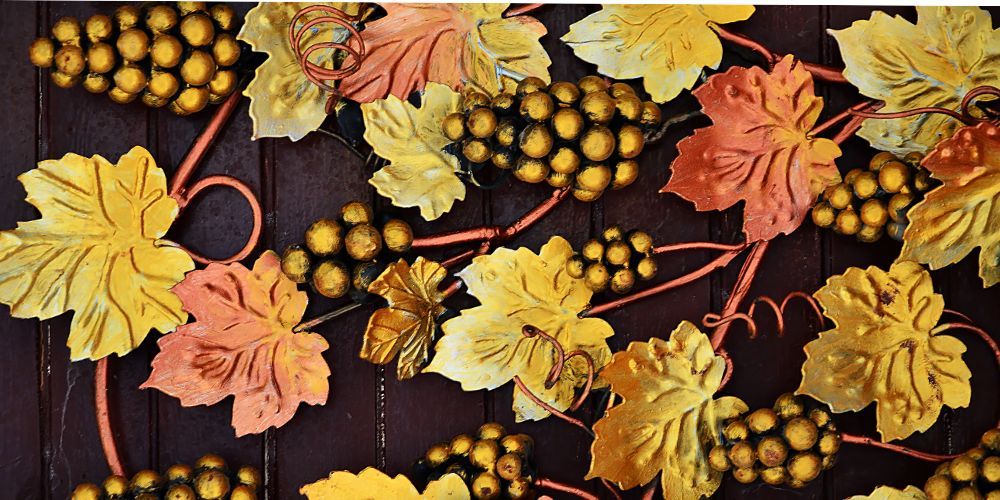
Walking through Florence it's easy to come across artisan shops where the most disparate objects are made, and of course the metalworking, in particular bronze, couldn't be missing. The Florentine bronzesmiths are in fact famous for their mastery; unfortunately today there are few left, who use the ancient techniques, however there are still workshops in town where bronze takes on every possible shape, and it is still handmade.
A short distance from Florence there is also one of the many enchanting villages of Tuscany, which also boasts a particular tradition. It is Scarperia, where the art of handmade knives has been handed down for centuries. The knives are reknown for their handles and blades so finely crafted that they look more like small works of art, than common tools. A very similar tradition is still found in Molise, in the small town of Frosolone. In both cases the flourishing local tradition is kept alive by two museums dedicated indeed to "sharp tools".
Molise also has another fascinating record. In Agnone there is in fact the oldest bell foundry still at work, whose art has been appreciated and respected for centuries even by the popes.
At the foot of the Marmolada, one of the highest peaks in the Dolomites, you can also find another artisan tradition still very much alive today. It's that of wrought iron, whose masters know how to bend iron into elegant swirls, or give it any shape the imagination suggests. In Perugia this art is still widespread as well; actually all throughout Umbria you can find small forges that have developed their own style, which differs from village to village.
Moving a few kilometres, then, you can arrive in Abruzzo, in particular in Guardiagrele, rightly considered the city of craftsmen. Here you will find shops where copper, iron or brass are worked, but there are also many goldsmith craftsmen who work this precious metal by hand, according to ancient techniques, creating jewels whose value goes far beyond that of the material.
Finally, speaking of gold, one cannot fail to mention the wonderful handmade filigree of the north of Sardinia. The artisans here can create one of the most typical and beautiful jewels of the Italian tradition. This is the Sardinian wedding band, a ring with an unmistakable style, which is handed down from mother to daughter and which has very ancient origins. According to the legend, the delicate gold filigree of which the ring is made was once woven by fairies in the moonlight.
Handmade in stone, in all of its shades
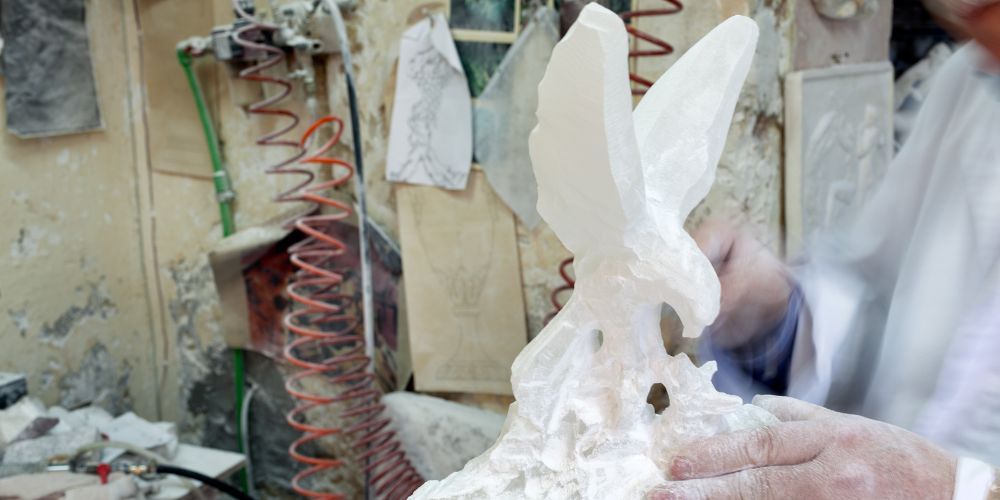
From the Alps to Sicily, all throughout Italy there are craftsmen capable of bending even stone to their own will, transforming marble, alabaster, tuff and many other minerals into beautiful artworks.
In Val d'Aosta, for example, the handicraft of soapstone is very popular. It's a dark green, compact stone that has been used among the peaks of the Alps since prehistoric times.
Central Italy, on the other hand, is famous for its marbles. It's yellow in Siena, green in Prato, and white in Carrara. The latter was the favorite of the greatest sculptors in history, such as Michelangelo who used it for his Pietà, or Canova who chose it for Cupid and Psyche.
Volterra, on the other hand, is a blooming of alabaster sculptures of all shapes and sizes, and among the many souvenir shops you can also find authentic handmade crafts.
In Tuscany, stone craftsmanship has also given rise to another form of art, the mosaic, known here as commesso fiorentino. Thanks to its many colors and the skill of the craftsmen, it was considered a painting made in stone. Fortunately, today the technique has not been lost and in Florence there are still artists who use it, creating exceptional artworks.
Southern Italy, instead, is the land of tuff and sandstone. Respectively in Matera and Lecce you can easily find a lot of excellent craftsmanship. The long and illustrious tradition can also be seen in the monuments, often made with these materials, such as the wonderful facade of the church of Santa Croce in Lecce.
In Italy music is handmade too
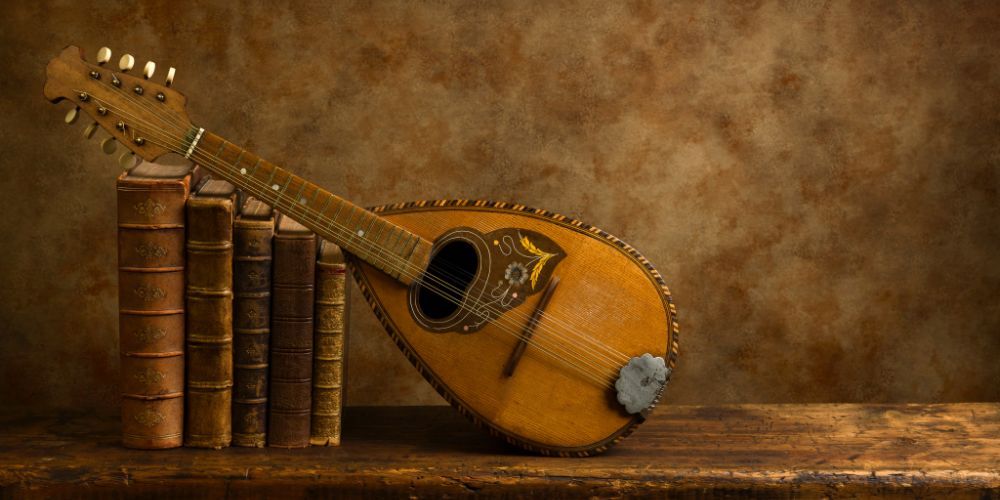
Music is another of Italy's great passions. From opera to Neapolitan song, passing through symphonic and folk music, there are many genres and all, in one way or another, have given rise not only to everlasting successes, but also to handmade musical instruments.
Cremona violins are certainly the most famous, both for their value and because their name is linked to that of Antonio Stradivari, the most famous luthier ever.
Cremona itself, however, together with Milan and Viterbo, is also known for the handcrafted production of keyboard instruments and flutes.
The sweet sound of the mandolin is instead inextricably linked to the Neapolitan song. In Naples, indeed, there are centuries-old shops where mandolins are still made with artisanal methods to be exported everywhere in the world. Still in Campania, but in the hinterland, zampogne are also produced. They are ancient wind instruments, similar to bagpipes, typical of pastoral culture, whose sound characterizes Christmas in southern Italy.
The southern regions, especially Calabria, are also known for handmade guitars. In fact, the construction of the so-called chitarra battente is still widespread here. It's the Italian guitar, which is slightly different from the classical guitar, of French origin.
About the author
Written on 07/02/2023



Paola Cirino
A journey to discover the extraordinary heritage of handmade in Italy, among places and traditions where the most ancient techniques are handed down.